Text
References
Jannetta, Ann Bowman. Epidemics and Mortality in Early Modern Japan. Princeton University Pres, 2016.
“Japan Infant Mortality Rate 1950-2019.” MacroTrends, https://www.macrotrends.net/countries/JPN/japan/infant-mortality-rate.
Lee, William. "Entering the Pure Land: Hanamatsuri and the Okagura Jodo-iri Ritual of Okumikawa." Japanese Journal of Religious Studies 33.2 (2006): 249-67. Web.
Loetscher, Jackson, Loetscher, Lefferts A., and Jackson, Samuel Macauley. The New Schaff-Herzog Encyclopedia of Religious Knowledge, Embracing Biblical, Historical, Doctrinal, and Practical Theology, and Biblical, Theological, and Ecclesiastical Biography from the Earliest times to the Present Day. Grand Rapids, Mich.: Baker, 1958. Print
Mitsui, Takafusa, et al. The Transactions of the Asiatic Society of Japan. Vol. 17-18, Asiatic Society of Japan, 1962.
Nishiyama, Yutaka. "A Study of Odd- and Even-Number Cultures." Bulletin of Science, Technology & Society 26.6 (2006): 479-84. Web.
Papp, Melinda. "Conspicuous Consumption in Postwar Japan: The Case of a Rite of Passage." Human Affairs 22.2 (2012): 196-213. Web.
Reyes-Ruiz, Rafael. "CONSTRUCCIONES JAPONESAS." Antípoda : Revista De Antropología Y Arqueología 1 (2005): 173-83. Web.
Sofue, Takao. "CHILDHOOD CEREMONIES IN JAPAN: REGIONAL AND LOCAL VARIATIONS." Ethnology 4.2 (1965): 148-164. Web.
0 notes
Photo




Traditions and ceremonies always stem from somewhere, usually in tragedy or great success. They evolve and change over time, sometimes to the point where people may not even remember when they started. I think it's important for us to make a conscious effort to remember the origins and to pass that knowledge and appreciation down to future generations for as long as we can because even something that we see as such a joyous occasion could have much darker roots.
0 notes
Text
Why more people should know about Shichigosan
The entire reason that Schichigosan exists is that thousands of children were dying during the Muromachi period. It started in a time that was riddled in death and disease. However, there is a bright side to this. The fact that people are forgetting why this tradition exists is a way of showing that we are doing something right. Infant mortality rates were astronomically high back then. Now the infant mortality rate in Japan is 1.764 deaths for every thousand live births. The fact that people do not have to worry about their healthy baby catching smallpox or measles shows a tremendous amount of social and medical progress. Many people do not know the origins of how Shichigosan started and I feel like more people should learn about it. I see it as a way of appreciating what we have achieved in this century and realize just how much has changed since then.
2 notes
·
View notes
Photo
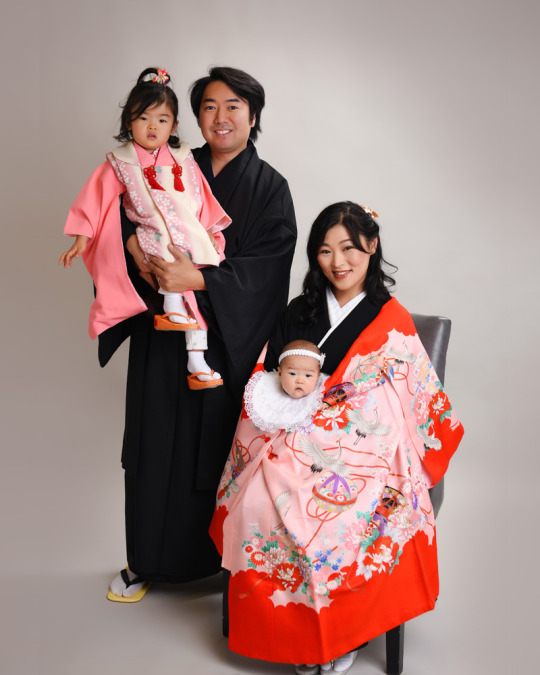



Since Shichigosan has turned into such a tradition in Japan, many business owners have capitalized on this event. Families now want to take extravagant pictures on the day of the ceremony and large family dinners. Photography businesses usually start putting up advertisements for “Shichigosan Packages” about a month before the event. On the day of the photo shoot, the family usually brings multiple sets of clothes to take pictures in. Many restaurants, flower shops, and other businesses that might carry balloons or other festive items seem to have a plethora of items just for Shichigosan. While the celebration around this event seems to have reached a new level, the origins seem to have been forgotten.
1 note
·
View note
Photo
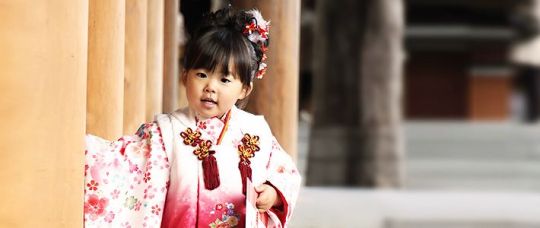

Back in the day, Shichigosan was seen by parents as a genuine “thank you” to the gods for the wellbeing of their child and to pray that they have a good future. Now, it has turned into much more of a family social event than a religious ceremony. People are much more flexible with the day they celebrate Shichigosan. Most people can not actually celebrate on the fifteenth so they go another day when they have time. Additionally, many parents no longer shave their baby’s head, so Kamioki mostly consists of simple dressing up, going to pray, and then taking professional photographs. While people still follow most other parts of this tradition, such as the garments, other much more extravagant things such as photoshoots have been added.
1 note
·
View note
Photo

The date and all the other numbers involved also have very interesting significance. First, all of the ages together add up to fifteen, which is the day that the ceremonies occur. All of the numbers involved were seen as suspicious in Japanese culture. Additionally, the date November 15th was chosen because it falls on Kishukunichi, or “the day the demons stay home”. This influenced the decision because if they were blaming evil spirits for all their misfortune, going out with your young children on this day would feel much safer. You would not have to worry about an evil spirit or demon on this day. I imagine it must have been very exciting for the kids to be able to go out with their parents all day.
1 note
·
View note
Photo
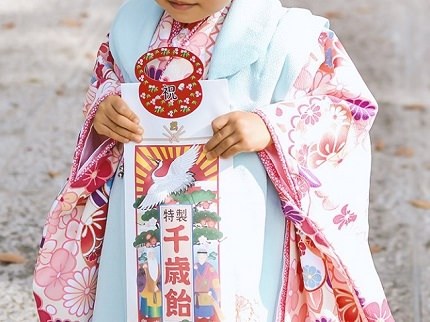

After each ceremony children receive two things while at a shrine: Chitose Ame and Okamori. Chitose Ame, or the thousand-year candy, are long and thin pieces of red and white candy. They represent good wishes and prayers for the child’s safety and prosperity. The number of Chitose Ame that they are given correlates directly to their age. If a three-year-old is participating in Kamioki, they get three pieces, and if a five-year-old is going through Hakama-no-gi then they get five pieces, and the same pattern follows for Obitoki-no-gi. The Chitose Ame are given to the kids in Okamori which are colorful bags ornately decorated with images of turtles or cranes. Both of which are animals that symbolize long life in Japanese culture.
5 notes
·
View notes
Photo



The third and last ceremony, Obitoki-no-gi, is celebrated by seven-year-old females. This is a female’s transition into womanhood. During this ceremony, the girl will put on an Obi and most likely some form of makeup for the first time. Obis are sashes that are worn over kimonos to help secure them in place. Obis in the Muromachi period were not like the extravagant and thick obis that can be seen today. They originally started as thin strings made from scrap pieces of fabric and were shaped as flat squares. During the Momoyama and into the Edo period, braided obis were very popular, but they started to become a little wider during the middle of the Edo period. Once fully dressed, the family would go to a shrine or a temple to pray just like the Hakama-no-gi ceremony.
2 notes
·
View notes
Photo
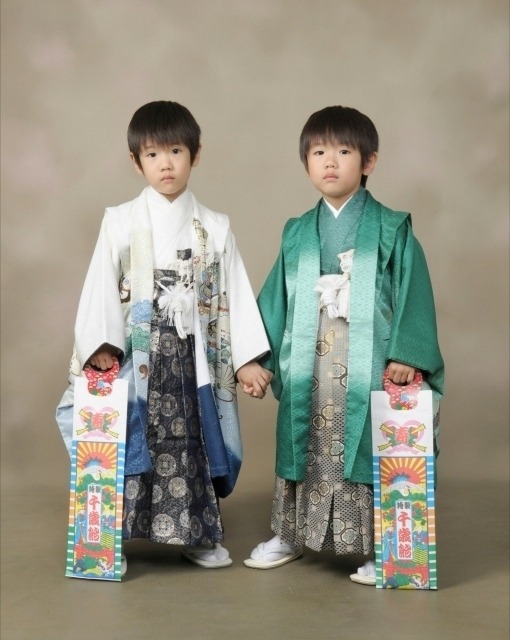

The second ceremony, Hakama-no-gi, is only for five-year-old males. This is when a boy wears a hakama and a haori for the first time. Both the hakama and the haori are traditional articles of clothing that were only worn by men. The haori is a kimono style jacket that is worn open or kept closed by a string. It is traditionally worn over a kosode (a type of short-sleeved undergarment). Hakama are very similar to large flowy pants, almost like a skirt. These garments are usually worn by the adult males of the family. When putting on this garment for the first time, the child is accepting that they are accepting the roles and responsibilities that adulthood comes with. After putting on the complete outfit the family would go to a shrine or temple to pray and thank the gods for their son’s life.
3 notes
·
View notes
Photo
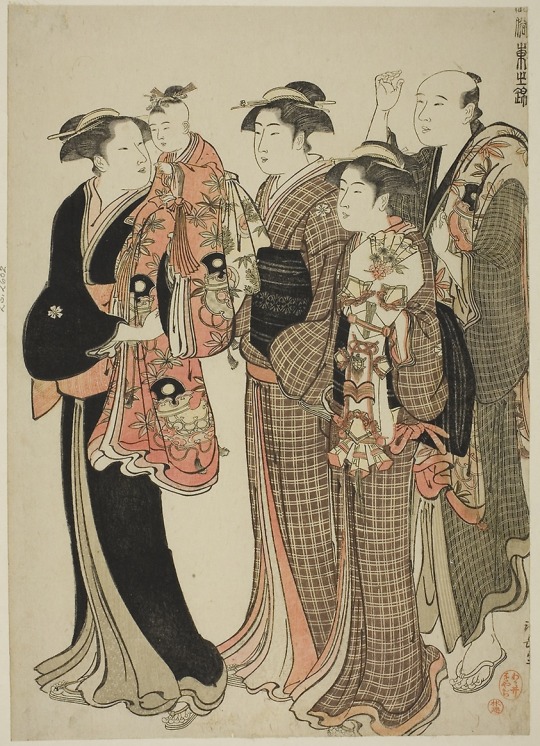


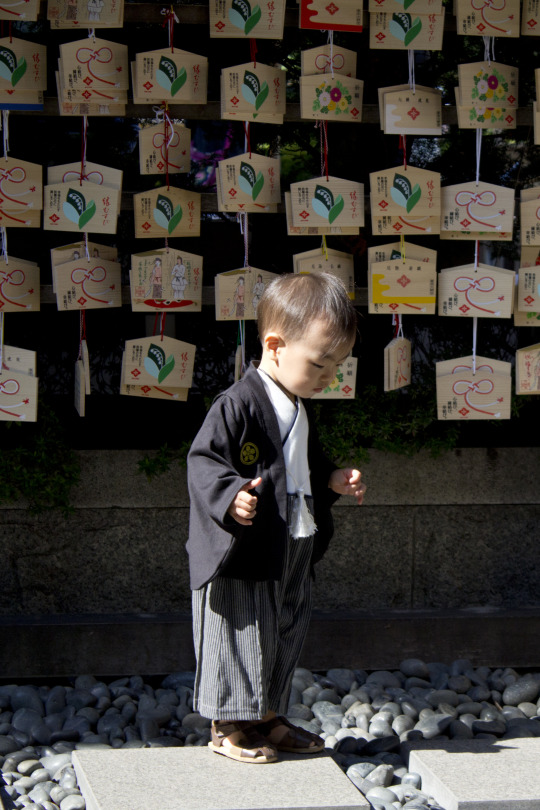
The first ceremony, Kamioki, as aforementioned takes place in a child’s third year of life. This is a ceremony that held great significance to parents during the time of high infant mortality. So, this was a time when parents would go to a Shrine and thank their deity for allowing their babies to reach three years of age. Additionally, this is when their hair is allowed to grow out. Back then it was very common to shave a baby’s head from the time they are born to three years old. There is insufficient research as to why this was a regular practice, however, it was believed that shaving a baby’s hair leads to more luxurious hair growth later on. However, in recent times it is much less common for parents to shave their infant’s head. Now they opt for a trim.
Artist: Torii Kiyonaga (1778-1789)
2 notes
·
View notes
Text
The Dark Origins of Shichigosan
While Shichigosan is seen as a purely joyous social event, it’s origin is fairly dark. Evidence of this ceremony can be dated all the way back to the Muromachi Period. During this time, there were many measles and smallpox epidemics that unfortunately led to the deaths of hundreds of thousands of children. In fact, the death rates were so high that the majority of Japanese families did not add newborn babies to their family registry until the age of three when the first ceremony takes place. Since this was way before germ theory, people were confused about all the death and illness, so they turned to religion. They started to blame evil spirits for the loss of their children. Shichigosan came about as a way for parents to thank their deities for allowing their children to survive to adulthood. There are three distinct comings of age rituals that make up Shichigosan (which will be discussed in later posts), that occur at different stages of a child’s life. These ceremonies all played a significant role in the lives of children in the Muromachi Period.
0 notes
Photo

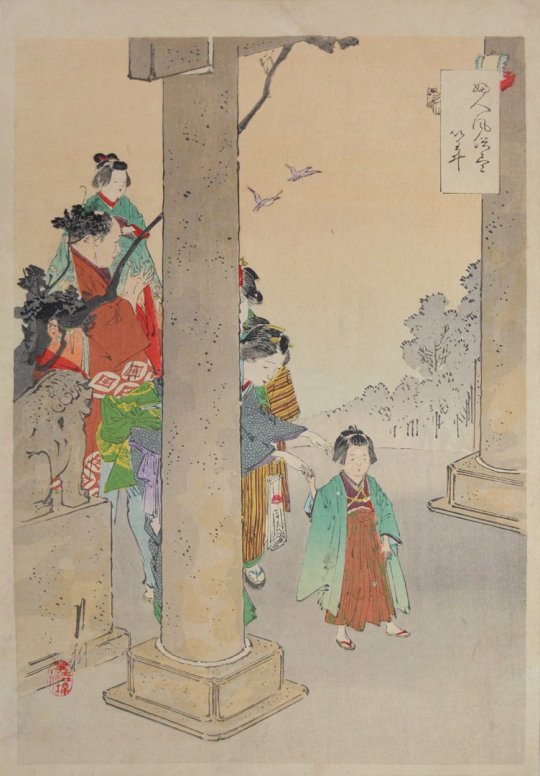
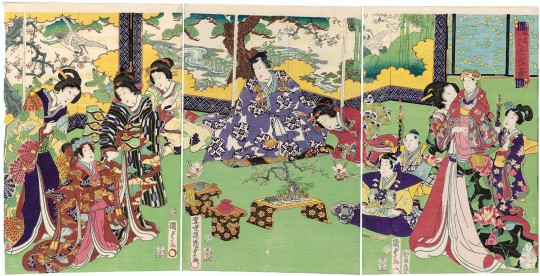
While all aspects of Shichigosan were widely celebrated by aristocrats in the past, in modern times it is celebrated by most Japanese families but seen as more of a family even rather than a religious ceremony.
Artist 1: Nobukazu Yosai (1874 -1944)
Artist 2: Gekko (1898)
Artist 3: signed Kunisada ga (on right and left sheets), Baichôrô Kunisada ga (on center sheet)
1 note
·
View note
Photo


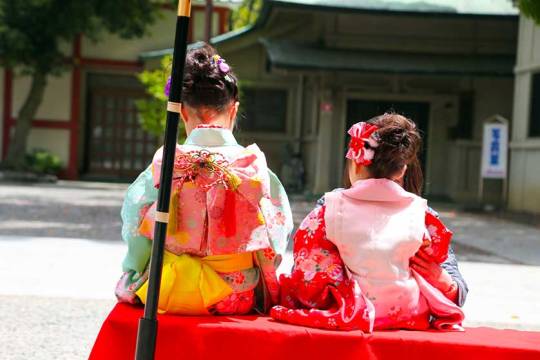
There are dozens of coming of age rituals and ceremonies all around the world. From Latin America’s quinceañeras, Jewish Bar and Bat Mitzvahs, and the Philippine Debut. However, one place that most people usually do not think of when asked about coming of age ceremonies is Japan. Known as Shichigosan, the ceremony consists of three independent ceremonies all of which are celebrated on November 15.
1 note
·
View note